Integrating Audyum: Practical Tips for Audiology Clinics
As healthcare advances toward digitalization, integrating new technologies in audiology clinics to improve patient care becomes essential. This evolution is not just about implementing software; it also involves a cultural shift in how professionals interact with technology and how it can be an ally in their daily work. The key to a successful transition lies in ensuring that all team members, regardless of their level of technical experience, feel empowered and confident when using digital tools.
Utilizing Audyum to Enhance Patient Care
In this context, Audyum has established itself as a platform specifically designed to simplify clinical management and enhance the experience of both staff and patients.
This short guide aims to help new users and staff who are less familiar with digital technologies; therefore, we briefly outline how you can approach the adaptation process to Audyum, with clear steps and effective strategies to ensure that the integration of new technologies in audiology clinics is a satisfying and uncomplicated experience. By empowering all team members, greater efficiency in operations can be achieved.
Integrating New Technologies in Audiology Clinics to Improve Patient Care
Registration and Initial Setup
he first step to start using Audyum is to create an account and configure the system according to the clinic’s needs. This process is designed to be intuitive, guiding the user through each step. Once the account is active, it’s crucial to personalize the initial settings, such as entering basic clinic information, schedules, and patient care preferences.
Interface Explanation
Once the setup is complete, familiarizing oneself with the Audyum interface is crucial. The platform features a clear and accessible main menu where key sections such as patient management, scheduling, sales, and billing tools can be found. Navigating these sections is straightforward, and the layout of visual elements facilitates quick identification of the most used functions.
How to Add and Manage Patient Data
Managing patient data is one of Audyum’s most important functionalities. Adding new patients can easily be done through forms designed to capture essential information, such as personal data, medical history, and contact preferences. Moreover, Audyum allows for efficient management of information, making it easier to update and access clinical records.
Demystifying New Technologies
For those who feel less comfortable using digital tools, it is essential to demystify technology. Audyum has been developed with simplicity in mind, and its fully customizable design helps reduce the learning curve. Each function is presented clearly, enabling users to focus on their primary tasks.
Tips for Quick and Effective Training
To facilitate adaptation, it is advisable to foster a supportive environment where users can share their concerns and experiences. Conducting group training sessions can be an excellent way to facilitate collaborative learning and resolve questions in real time. Additionally, encouraging team members to explore the platform together and share their discoveries can also help build confidence in using Audyum.
Using Automated Tools
Taking advantage of Audyum’s automated tools, such as appointment reminders and patient follow-up management, can significantly simplify daily tasks. These features not only save time but also reduce the risk of errors.
Strategies for Integrating Users with Less Experience
Progressive Adaptation Plan
Establishing an adaptation plan that includes small and manageable tasks is crucial for less experienced users to familiarize themselves with Audyum. Starting with basic functions, such as scheduling appointments or entering patient data, allows new users to feel comfortable with the platform before moving on to more complex features. Gradually, additional functions should be introduced.
Continuous Feedback
Implementing a continuous feedback system is key to understanding users’ training needs. For example, conducting surveys or feedback sessions where employees can express their concerns and suggestions about the platform can provide valuable insights. Based on this feedback, training and development strategies can be adjusted to ensure that areas of difficulty are adequately addressed.
Celebrating Achievements
It is important to recognize and celebrate users’ small achievements as they progress in their learning. This can include organizing meetings to share successes, as well as providing informal recognition in daily interactions. Consequently, positive reinforcement not only increases motivation but also promotes an environment where employees feel valued and more willing to continue learning.
Access to Support
Ensuring that all team members know they have access to a readily available support team is vital. Clearly communicating how to access this support and what kind of help can be received can make users feel more secure and supported in their adaptation process. Fostering confidence that they are not alone in this learning journey can reduce anxiety and facilitate the transition.
Integrating Audyum in audiology clinics not only optimizes internal processes but also enriches patient care by making it more effective and personalized. By following a gradual approach and with the support of colleagues and the support team, any user, regardless of their level of experience, can successfully adapt to this tool.
Don’t wait any longer to enhance the experience in your clinic! Contact us today to schedule a free demonstration of Audyum and discover how we can help transform your practice!
Links of Interest:
- To learn more about health digitalization, you can read about Digital Health: The Future of Healthcare.
- Discover the latest trends in audiology technology that may influence your practice.
- Consult studies on improving patient care through technology to see examples and statistics.
